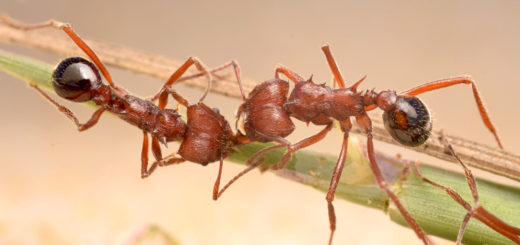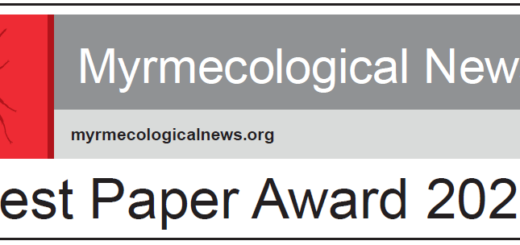Relatedness of cooperatively breeding queens in the leaf-cutting ant Acromyrmex echinatior
In their paper “Reconstructing the relatedness of cooperatively breeding queens in the Panamanian leaf-cutting ant Acromyrmex echinatior (Hymenoptera: Formicidae)” published in Myrmecological News in May 2018, Volker Nehring, Michiel B. Dijkstra, Seirian Sumner, William O.H. Hughes, and Jacobus J. Boomsma reveal that the overall frequency of polygynous colonies in Acromyrmex echinatior is about 8% with typically two queens per colony.
A Review compiled by Claudie Doums 
The ancestral state of all ants is monogamy in which a single queen (monogyny) mates with a single male (monandry) and stores his sperm for her entire life (Hughes & al. 2008). All workers raised by the queen are therefore full sisters, and their common genetic and environmental backgrounds confer them a high ability in discriminating aliens from nestmates, thereby preventing the potential exploitation of colony resources by aliens. However, in many ant genera, diverse ecological pressures have led to the evolution of secondary polygyny, generally characterized by the adoption of related daughter queens mated with different males. By increasing the genetic diversity within the colony, secondary polygyny reduces the reliability of nestmate recognition thus running the risk of occasional mistaken acceptance of alien queens into the colony. This opens the way for the evolution of social parasites in ants, especially of inquiline social parasites.
Queens of inquiline social parasites are able to infiltrate a colony of a different species and to reproduce with the help of foster workers alongside the host queen(s) without having to go into the very risky step of founding a colony alone (Bourke & Franks 1991). The Austrian entomologists Carlo Emery and Erich Wasmann realised that many ant social parasites are closely related to their hosts. They proposed that the evolution of inquiline parasites occurred through sympatric speciation from sister lineages, one being selected for exploiting the other. This came to be known as Emery’s rule (Bourke & Franks 1991, Buschinger 2009). Reproductive isolation and disruptive selection could ultimately lead to a new species of social parasite, unable to live without its host (Boomsma & Nash, 2014).
Inquiline social parasites have evolved multiple times, including in species where the default breeding system is monogyny so that they have high discriminatory abilities, such as in the leaf-cutting ants of the genus Acromyrmex. According to Emery’s rule, low levels of secondary polygyny with occasional mistakes and adoption of alien queens are a necessary prerequisite for the evolution of inquiline social parasites. Providing evidence of rare events is always highly challenging for evolutionary biologists. Based on an impressive collection of colonies (203) over more than 20 years, associated to elegant genetic analysis of 45 of these colonies, Nehring & al. (2018) convincingly showed the rare occurrence of polygyny (8%) in colonies of the monogynous leaf-cutting ant Acromyrmex echinatior, with polygynous colonies expressing a low level of polygyny with typically only two queens. Even though most of these queen pairs were genetically related, fitting the adoption of daughter queens, very few (1% of all colonies) were unrelated.
The results obtained by Nehring & al. (2018) provide evidence that the basic requirement of secondary polygyny as an opportunity for the evolution of inquiline social parasites is fulfilled in the primarily monogynous leaf-cutting ant A. echinatior. The high morphological similarities but lower size of the social inquiline A. insinuator compared with its host, its conserved faculty to produce at least partially the worker caste (Schultz & al. 1998, Bekkevold & Boomsma 2000), and its chemical camouflage (Nehring & al. 2015) suggest that A. insinuator is at the early stage of the evolutionary transition towards fully derived social parasite characteristics. Molecular work is now required to provide support of the recent evolution of the social parasite from its related host. If recent evolution is confirmed, A. echinatior and its social parasite A. insinuator could provide an exceptional model system to shed light on the first evolutionary steps necessary for the evolution of fully derived social-parasite traits.
 Acromyrmex echinatior queen and workers on the fungus garden (© Volker Nehring)
Acromyrmex echinatior queen and workers on the fungus garden (© Volker Nehring)
References
Bekkevold, D. & Boomsma, J.J. 2000: Evolutionary transition to a semelparous life history in the socially parasitic ant Acromyrmex insinuator. – Journal of Evolutionary Biology 13: 615-623.
Boomsma, J.J. & Nash, D.R. 2014: Evolution: Sympatric speciation the eusocial way. – Current Biology 24: R799-R800.
Bourke, A.F.G. & Franks, N.R. 1991: Alternative adaptations, sympatric speciation and the evolution of parasitic, inquiline ants. – Biological Journal of the Linnean Society 43: 157-178.
Buschinger, A. 2009: Social parasitism among ants: a review (Hymenoptera: Formicidae). – Myrmecological News 12: 219-235.
Hughes, W.O.H., Oldroyd, B.P., Beekman, M. & Ratnieks, F.L.W. 2008: Ancestral monogamy shows kin selection is key to the evolution of eusociality. – Science 320: 1213-1216.
Nehring, V., Dani, F.R., Turillazzi, S., Boomsma, J.J. & d’Ettorre, P. 2015: Integration strategies of a leaf-cutting ant social parasite. – Animal Behaviour 108: 55-65.
Nehring, N., Dijkstra, M.B., Sumner, S., Hughes, W.O.H. & Boomsma, J.J. 2018: Reconstructing the relatedness of cooperatively breeding queens in the Panamanian leaf-cutting ant Acromyrmex echinatior (Hymenoptera: Formicidae). – Myrmecological News 27: 33-45.
Schultz, T., Bekkevold, D. & Boomsma, J.J. 1998: Acromyrmex insinuator new species: an incipient social parasite of fungus-growing ants. – Insectes Sociaux 45: 457-471.

Acromyrmex echinatior workers on the fungus garden (© Volker Nehring)





Recent Comments